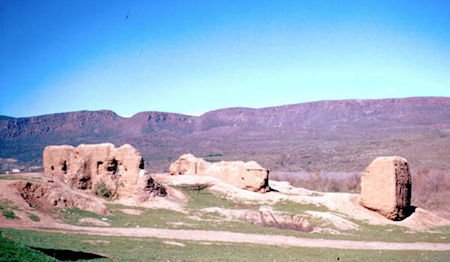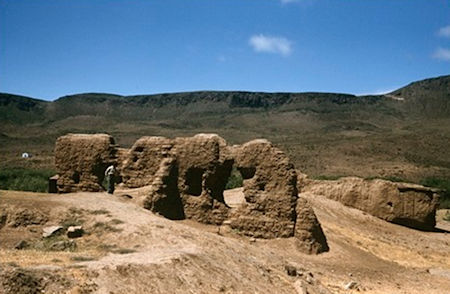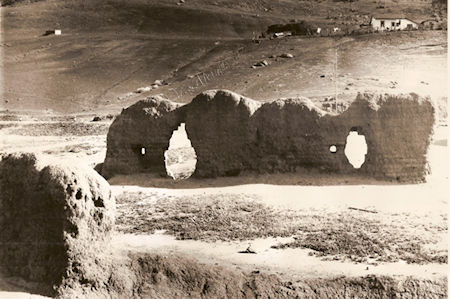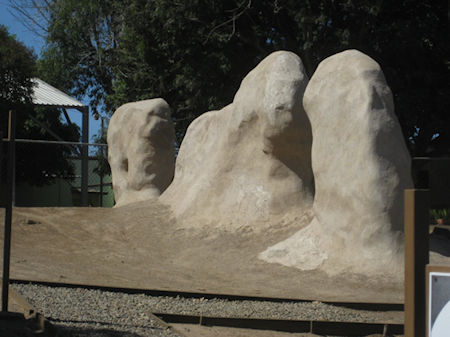 |  |
By David Kier

Missions were the method Spain used to instruct indigenous people on becoming productive subjects of the King, learn to speak Spanish, and convert their religious beliefs to Christianity. Many tribes accepted the new way of life, but a few fought this foreign intrusion. The Spanish established twenty-five missions on the peninsula of Baja California. Nearly half these missions were relocated. Usually, this was for better water supply or farmlands. Some missions moved two or more times! Let us take a look at one such mission...
After many delays, the Dominican Order founded their fourth California mission, joining those founded by the Jesuits and Franciscans as the twenty-second mission on the peninsula. As so typical with establishing new missions, these endeavors did not always happen without problems. As we will learn, the San Miguel mission moved between three locations, over the years. After the mission was abandoned, a Mexican settlement was established called La Misión Vieja de San Miguel. The name eventually was shortened to just La Misión.
Mission San Miguel’s founding was delayed due to hostilities at the 1780 mission of San Vicente Ferrer and by the Yuma massacre in 1781. That event destroyed the two Colorado River missions and took around one-hundred people’s lives, including four Franciscan missionaries, and California’s Lieutenant Governor Fernando Rivera y Moncada. As a soldier, Rivera had done so much to assist the Jesuits and Franciscans on their expeditions into new lands. On October 24, 1781, Spain’s King Charles III commanded that new missions be established at once to connect the settlements of Baja and Alta California. The Camino Real had to be protected!

Padre Luis Sáles of Mission San Vicente, explored for a new mission site and thought he found a good one along a creek named El Encino (The Oak Tree). Two years earlier, Governor Fages had identified the location of El Encino as a good mission site with abundant pasture, rich lands, and accessible water. It also was on the El Camino Real, midway between San Vicente and San Diego. Padre Juan Crespí had previously named this valley, San Juan Bautista, during the first overland expedition to San Diego. On May 9, 1769, Crespí had written a detailed account of the friendly tribes and their village of huts in this valley, with plenty of water. He believed this would make a good mission site. Padre President Junípero Serra also camped here on June 25, as part of the second 1769 group traveling from Loreto to San Diego. Serra named this valley, San Juan Capistrano.
The mission was founded on March 28, 1787, by Padre Sáles. It was casually known as San Miguel Encino or San Miguel de la Frontera. Dominican mission researcher and author Peveril Meigs was unable to find any remains of the first mission site in 1928. Evidence would seem to be place it by a ranch named La Misión, near the old trail and east of the edge of a high plain. This ranch, among oak trees, still exists on modern maps. The Dominican letters had not mentioned the Franciscan’s earlier comments about this valley. Apparently, they both independently discovered this area was a good mission location with many friendly native tribes.

For several months, all seemed to be going well. Rooms and a chapel were under construction with crops planted and 137 baptized Indians had joined the mission. Then, the spring stopped flowing! About this time, a chief of the Kwatl tribe arrived at the mission, near death, suffering from the bite of a rattlesnake (another version says it was the chief’s son). Padre Sáles treated the bite with an oil that cured the chief. So grateful was he, the chief invited Sáles to move the mission to his village, about six miles west. Not only did it have abundant fresh water but all other conveniences necessary for a mission’s success.
The new location was near the coast, with abundant seafood. Plus, the La Salina salt flat was not too distant, and salt was a valuable product for food preservation and trade. The name for the new mission site was Ja-kwatl-jap, which meant ‘Hot Water of the Kwatl tribe,’ for the nearby thermal springs. The move from El Encino to Ja-kwatl-jap was made in 1788, according to a letter from Governor José Arrillaga.
Padre Sales may not have been aware of a 1773 boundary marker, placed by Franciscan Padre Francisco Palóu, about ten miles north of San Miguel. It served as a division between Dominican Baja California and Franciscan Alta California. In 1788, Sáles traveled fourteen miles beyond the marker to meet new tribes to add to his fold. These tribes had already been preached to from padres of the San Diego mission! Padre Sáles fed and instructed them back at San Miguel. He baptized their chief, his wife, and children, plus nine young women between fifteen and twenty years of age. When the governor learned of Sáles intrusion into Franciscan territory, rather than scold him, he moved the official boundary fourteen miles north to Arroyo Rosarito where it remained until 1848 at the end of the Mexican War.

From surviving documents, we learn that Sáles built the mission like a fortress. The whole enclosure was practically a square with walls and towers on the north and west. The church and living quarters were in the east and south. The enclosed open court was fifty yards wide and sixty yards long. Tho only entrance was a gate at the southeast corner of the quadrangle, and this was protected by a guardhouse. The road from the southeast led to the gate. Outside the walls on the north and west ran a steep embankment and at the foot of this, an irrigation ditch curved from east to west. Looking north, is the broad San Miguel Valley with the Guadalupe River about five hundred feet away. On the south the steep walls of the canyon rose seven hundred feet. To the east are tablelands rising to 1,700 feet, except for the gashes cut out by the river and the tributary arroyos. To the west in the valley were irrigated fields. There was about a square mile of grazing in the valley to the east.
The mission’s population increased to 256 by 1797. In 1806, the mission’s population was 262. Principal crops were maize, wheat, barley, beans, and melons. Grapes were grown to make wine and brandy, not used at the mission but sold to obtain clothing and utensils for the local tribes.
Dominicans who followed Sáles at San Miguel include: Caietano Pallás 1790-1791; Juan Salgado 1792-1793; Mariano Yóldi 1793-1804; Mariano Apolinário 1794-1796; Raymundo Escolá 1797-1800; Miguel Abád 1799; and Tomás de Ahumada 1809-1815

Shortly after Padre Ahumada arrived at San Miguel, flash floods had destroyed the mission farmlands. By 1810, the mission was moved north to the Descanso Valley and remained there for the next four years. At Descanso, it was called San Miguel la Nueva (New San Miguel), and the previous location was called San Miguel la Vieja (Old San Miguel). A letter written by Padre Ahumada in 1815, prior to his going south on a new assignment, was from the older mission location.
In 1815, Ahumada was replaced by Padre Félix Caballero. Caballero experienced the transition from Spanish California rule to Mexican Independence. In 1822, some Dominicans pledged loyalty to the new Mexican government. The other Dominicans had instead chosen to leave the peninsula. Caballero seemed to think he could act alone on matters that previously required permission from his Dominican superiors and the Spanish governor. One of these actions was in 1830 to establish a new mission at Descanso. This he did with the help of a local chief and his tribe. This new Descanso mission was across the valley from where Padre Ahumada had moved San Miguel, in 1810. More on El Descanso: https://www.bajabound.com/bajaadventures/bajatravel/el_descanso
Today, the foundations of the 1830 mission are next to a church, just ½ mile east of Highway One (Km. 49). These foundations are partially protected by a steel awning. The information sign there is not quite accurate, with a founding date of 1817 given. That year was an estimation made by author Peveril Meigs, in his 1935 book, The Dominican Mission Frontier of Lower California. Since then, new Dominican letters have surfaced to give the more exact date of 1810. In addition, that date was for the moved San Miguel mission, not the newer mission of 1830. Meigs wrote in his book that ruins on the ridge south of the Descanso ruins were [he believed] that of a fort. More likely, this was the moved San Miguel mission of 1810. It is located on the south rim of the Descanso valley in the same manner as it was in the San Miguel valley. Today, a cemetery is on the moved mission remains where old adobe bricks were observed. Padre Caballero was also busy at other missions, such as Santa Catalina, San Vicente, and Santo Domingo. In 1834, Padre Caballero closed both El Descanso and San Miguel when he opened his new mission of Guadalupe. More about Caballero: https://www.bajabound.com/bajaadventures/bajatravel/the_controversial_padre.php
Padre José Martínez was the last resident missionary at San Miguel, 1819-1822. Padre Domingo Luna was the final Dominican recorded at the mission and performed services in 1829 and 1833.
See the preserved ruins of San Miguel, located next to the La Misión school, Highway #1, Km. 65.5.
References:
Fray Juan Crespi, Missionary Explorer on the Pacific Coast 1769-1774 by Herbert Bolton, 1927
The Missions and Missionaries of California by Fr. Zephyrin Engelhardt, 1929
The Dominican Mission Frontier of Lower California by Peveril Meigs III, 1935
The Dominican Mission Foundations in Baja California, 1769-1822 by Albert Nieser, 1960
Byroads of Baja by Walt Wheelock, 1971
Baja California: Vanished Missions, Strange Stories Tall and True by Choral Pepper, 1973
Baja California and its Missions by Tomás Robertson, 1978
Gateway to Alta California, The Expedition to San Diego by Harry Crosby, 2003
Baja California Land of Missions by David Kier, 2016

The level of service I have received from Baja Bound (Yara) has been nothing less than exceptional....

Great insurance! Bought one year but was cured in 2 days on my visit to El Sauzal de Rodriguez next...

Changed some money. Good rate and friendly people.